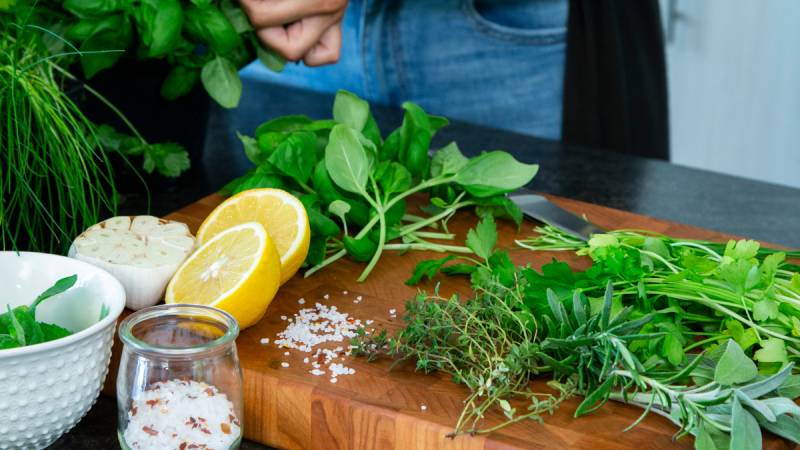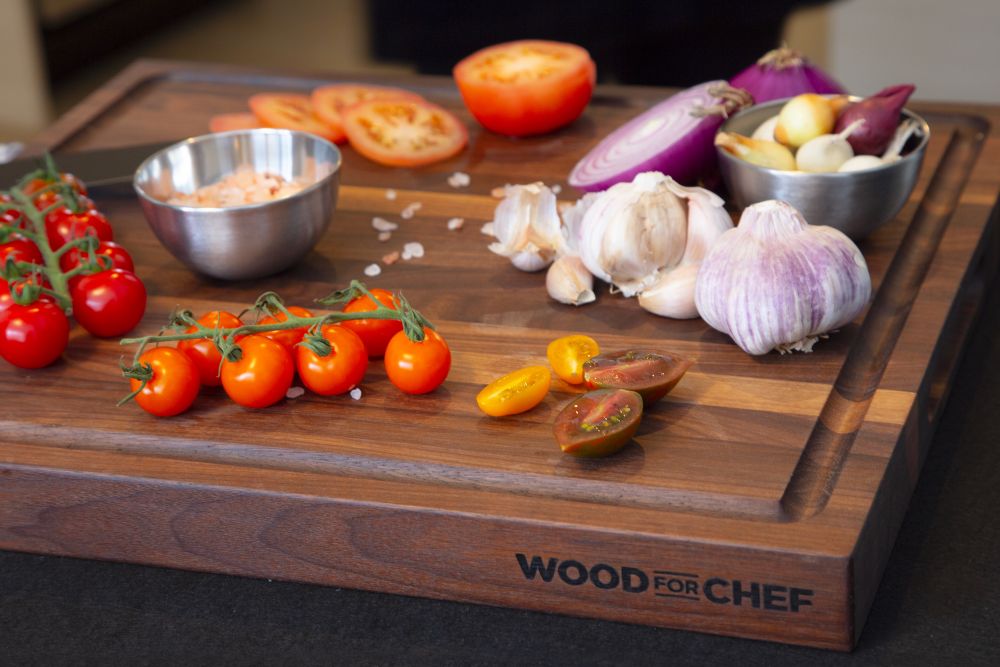Are you a budding chef or a long-time foodie? Are you looking to level up your culinary prowess with some more sophisticated kitchen equipment? Then it’s time you considered getting yourself a butcher block cutting board. More than just a slab of wood, a butcher block is the best type of cutting board money can buy. The origin of butcher blocks dates back to the traditional use of these cutting surfaces in butcher shops and meat processing plants, where ruggedness and durability were key to withstand endless carving and chopping.
Butcher block cutting boards are made using thick strips or blocks of wood that are bonded together, typically in edge grain and end-grain assemblies. Here are the differences between these types of butcher blocks:
- Edge-grain butcher blocks: Made by gluing the faces of the strips of wood together so that the edge grain side is the cutting surface. They are renowned for their high moisture resistance and easier care/maintenance for day-to-day use
- End-grain butcher blocks: Cut from pieces of lumber into blocks, they are glued together with the end grain facing upwards. These preserve knives’ sharpness because cuts are made on the short grain. They also display very few lasting marks. However, they tend to be more expensive due to the complex manufacturing process.
Many professional chefs and home cooks use edge-grain butcher blocks because the edge of the grain is the wood’s strongest part, and the knife marks don’t appear quite as easily.
Now that you know a little bit more about the different types of butcher block cutting boards, let’s look into some common questions we’re asked when people shop for butcher blocks.
How to properly care for and clean a butcher block?
With its intricate construction, a butcher block requires a certain level of care to maintain its look and functionality. Caring for a butcher block isn’t complicated but should be routinely maintained. Regular oiling with butcher block oil is key. Depending on usage, you can apply a food-safe mineral oil every month on your butcher block cutting board. Butcher block oil enhances the rich hues and grain of the wood and prevents it from drying out or moisture getting in.
Protect your butcher block from heat and direct sunlight. Keep it away from moisture and water by putting it somewhere elevated or on a breathable surface. Failure to do so can cause the wood to crack and warp or develop mold or bacteria.
Cleaning butcher blocks is easy. Simply scrape off any food residue with a knife or flat spatula. Use mild dish soap and warm water to scrub the butcher block with a soft dishwashing cloth or brush. Never soak your butcher block for prolonged periods of time because the water can cause the wood to split or warp. Once it has been thoroughly cleaned, fully dry the butcher block immediately with a clean towel. Need a deeper clean? Scrubbing it with lemon juice or coarse sea salt can do wonders for a butcher block cutting board. Ensure your butcher board is completely dry by standing it vertically so that both faces are exposed. Only then can you re-apply any butcher block oil.
If your butcher block starts to feel rough or shows signs of wear and tear, you can lightly sand it and then reapply butcher block oil.
What types of wood are the best for butcher blocks and why?
As you shop around for your next butcher block, keep in mind that some types of wood are better than others for butcher blocks. Always choose a butcher block with a hard, dense, tight-grained wood. The reason? The wood will be able to hold up to the repetitive force of cutting with knives—all while protecting your knives’ edges from becoming dull.
Many butcher blocks are made with hard maple; Hard Maple has been manufacturers’ go-to wood choice for butcher block cutting boards for years. Other wood species you can choose are: Cherry, Walnut, Beech, White Oak and Teak. All of these species are very durable and water-resistant.
On the other hand, the wood species you should avoid are pine and red oak because they have open grains, making them less durable for cutting-board use. Furthermore, open-grain wood can trap food particles, which can lead to bacterial and mold growth, odours, and even contaminate food taste.
What other purposes can a butcher block serve in the kitchen?
Did you know that a butcher block can be used for a wide array of purposes than just cutting food? Here are some other aesthetic and functional reasons to buy a butcher block cutting board:
- Serving platter: A butcher block can double as a rustic serving board for charcuterie and cheese, bread and crackers, and even desserts.
- Baking: Use your butcher block to knead dough and roll out pastries.
- Bar board: A butcher block can also be a prepping and serving board for drinks.
- Heat protection: Butcher blocks are ideal to protect your countertops and table from hot pots and pans.
- Arts and crafts: Some use their butcher blocks as a sturdy surface for painting, gluing and the like; however, be sure to properly clean your butcher block cutting board if you plan on using it for cooking!
- Decorative base: Because of their warm, earthy undertones, butcher blocks can be found gracing counters and tables with candles and plants for a stylish atmosphere.
What are the benefits of using a butcher block compared to other types of cutting boards?
Butcher block cutting boards offer many advantages over other types of cutting boards made from plastic, glass, stone, silicone, rubber and composite cutting boards.
For one, because they are made from hardwood, butcher block cutting boards are incredibly durable. They can last for decades if they are cared for properly. Unlike other cutting board materials, such as those made with plastic, composite and silicone, wood butcher blocks don’t easily chip, break or degrade over time. In addition, butcher blocks are gentler on knives. The last thing you want is to invest in a set of premium knives—only to have their edges ruined by a cheap cutting board.
Especially in the case of end-grain butcher blocks, butcher block cutting boards have a self-healing ability where the wood fibers close back up post-cut, diminishing the visibility of knife marks. The inherent antibacterial properties of wood can make butcher blocks more hygienic than damaged cutting boards with other materials, which can harbour bacteria in the grooves.
Can butcher block get wet?
A butcher block can get wet for short periods of time, like when you clean it. While butcher blocks are impervious to liquids, prolonged exposure to moisture can cause several problems to arise, from bacteria and mold growth to warping and cracking. When a butcher block is subject to a lot of water and certain types of food, it can become permanently stained. Finally, if your butcher block cutting board is constantly wet, its finish and oil coating will break down, reducing its useful life.
Why oil a butcher block?
As previously mentioned, it is important not to skimp on caring for your butcher block cutting board. Frequently using butcher block oil will protect your cutting board from stains and odours, preserve its durability and aesthetic appearance, and ensure optimal water resistance.
Specialized butcher block oils that are food safe are the only types of oils you should use on a butcher block. Do not use cooking or vegetable oils because they can quickly become rancid.
As you can see, a butcher block cutting board is an indispensable asset in any kitchen. Interested in shopping for a high-end butcher block cutting board in Canada? Look no further than WoodForChef!
Buy WoodForChef butcher block to enhance your time spent in the kitchen

